Giảm thiểu yếu tố tâm lý cản trở học viên quân sự thực hành nói tiếng Anh
Kỹ năng nói tiếng Anh là một trong những kỹ năng ngôn ngữ quan trọng vì nó thể hiện trực tiếp
và rõ ràng trình độ của người học. Tuy nhiên, kỹ năng nói của người học, đặc biệt là học viên quân
sự khối các ngành kỹ thuật, còn hạn chế. Để tìm hiểu nguyên nhân và đưa ra giải pháp cho vấn
đề này cần có một nghiên cứu quy mô trên diện rộng. Trong khuôn khổ bài báo này, người viết sẽ
tổng hợp lại các yếu tố tâm lý cản trở người học nói chung trong việc thực hành nói tiếng Anh. Từ
đó, người viết đưa ra đề xuất nhằm giảm thiểu các trở ngại tâm lý đó cho học viên khối quân sự
đang học tập tại Học viện Kỹ thuật Quân sự thông qua việc xây dựng môi trường thực hành ngôn
ngữ tự nhiên, thiết kế bài giảng với các chủ đề và các hoạt động thực hành nói phù hợp với trình
độ của người học.
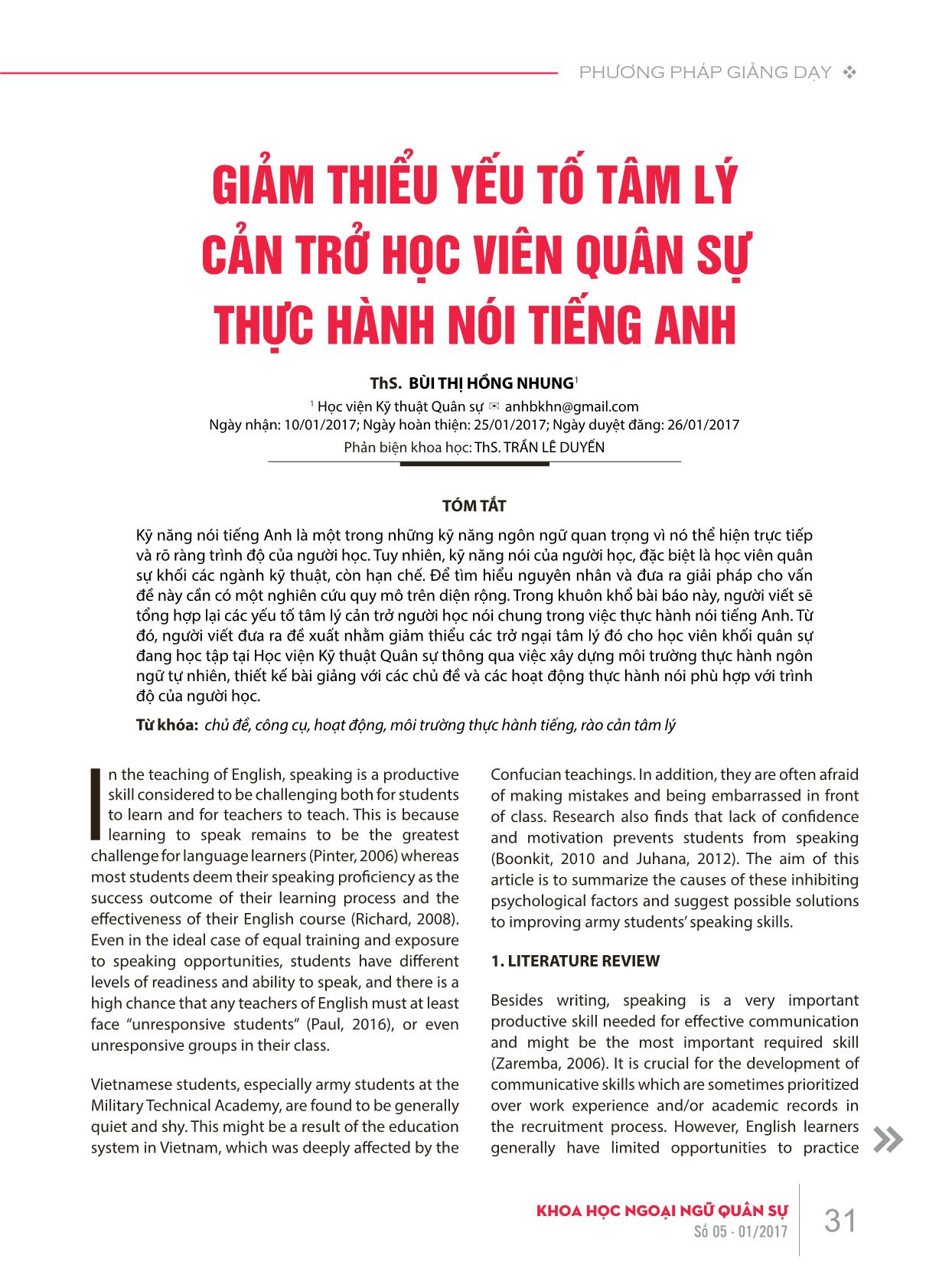
Trang 1
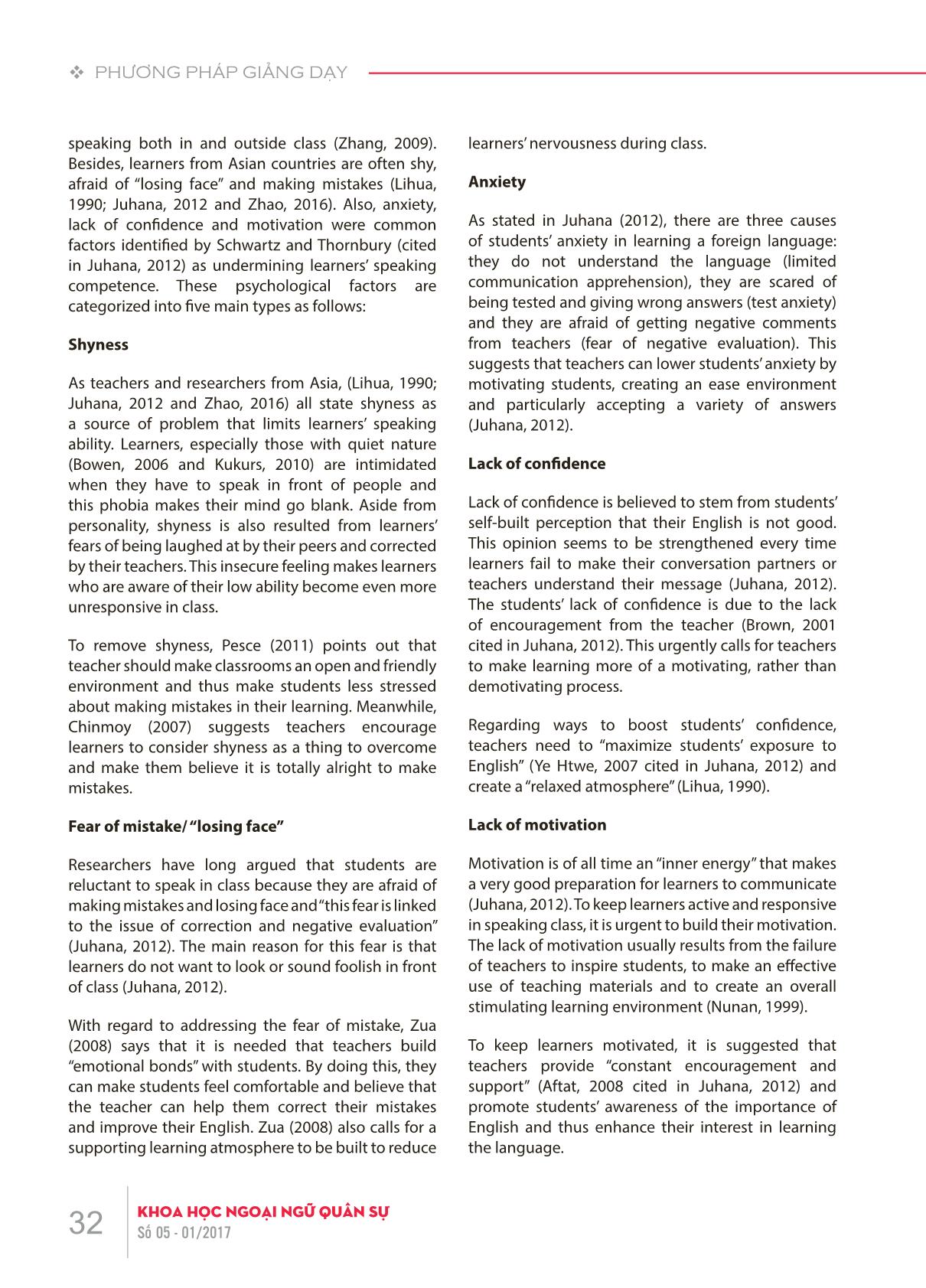
Trang 2
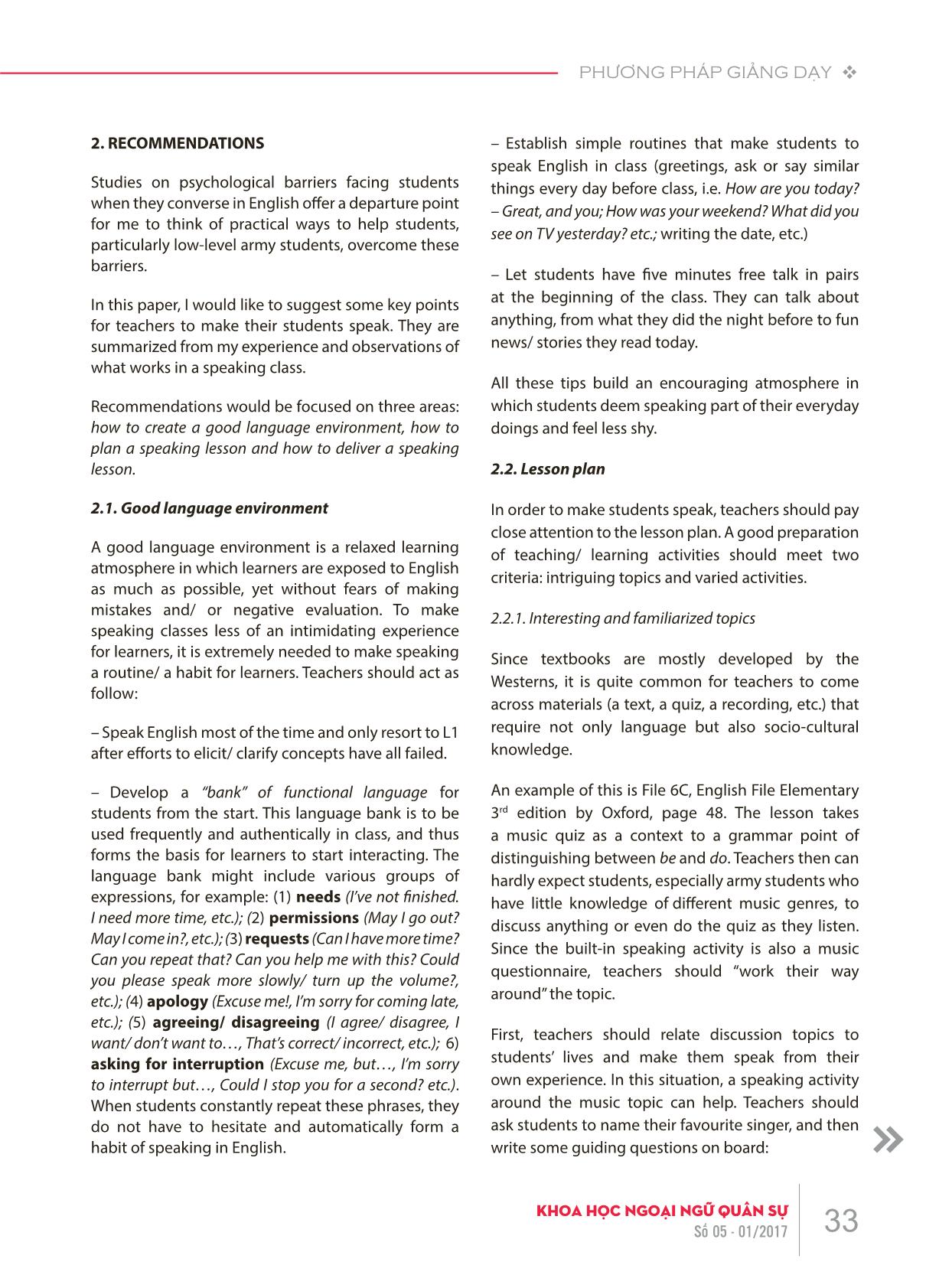
Trang 3
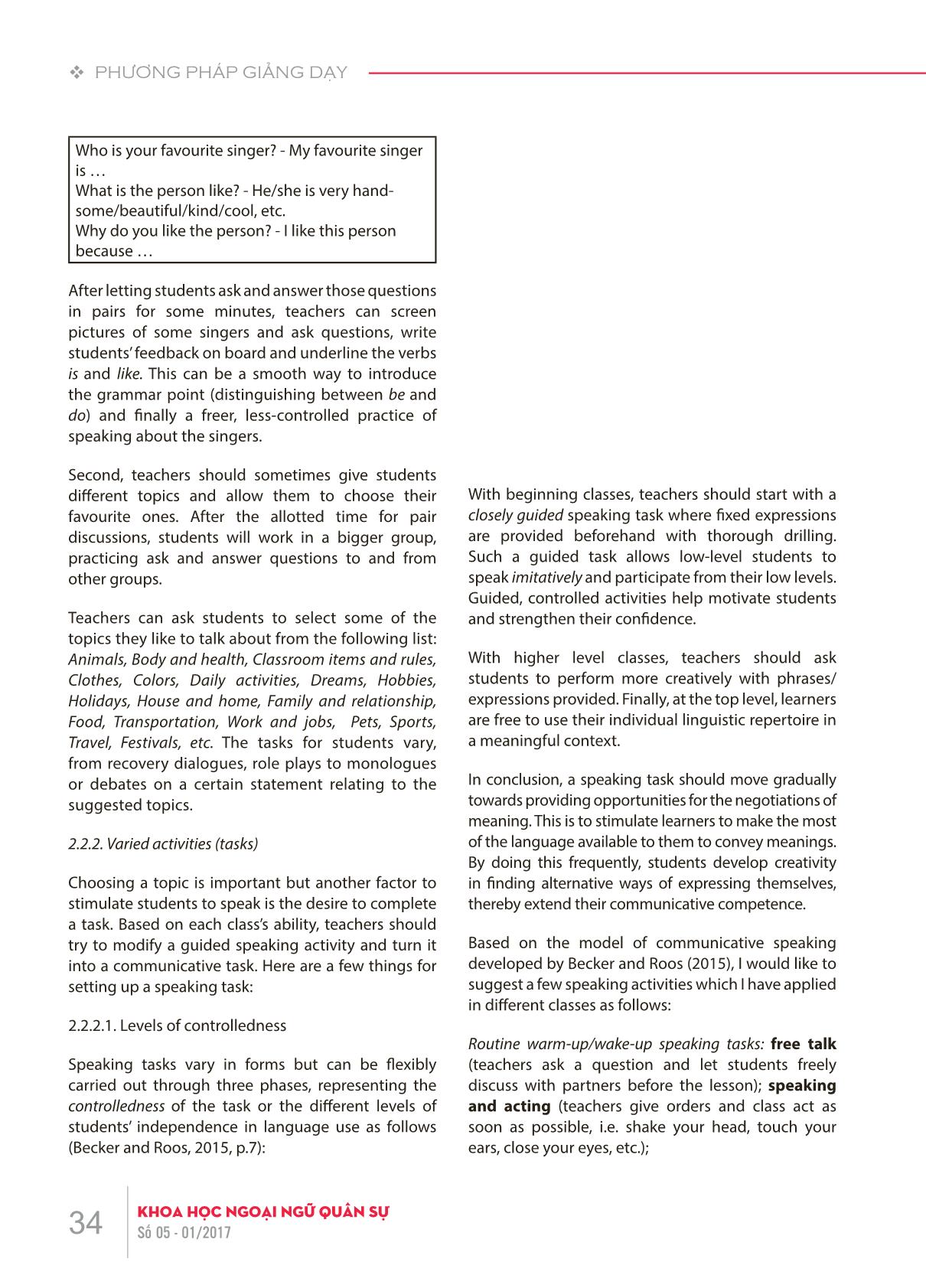
Trang 4
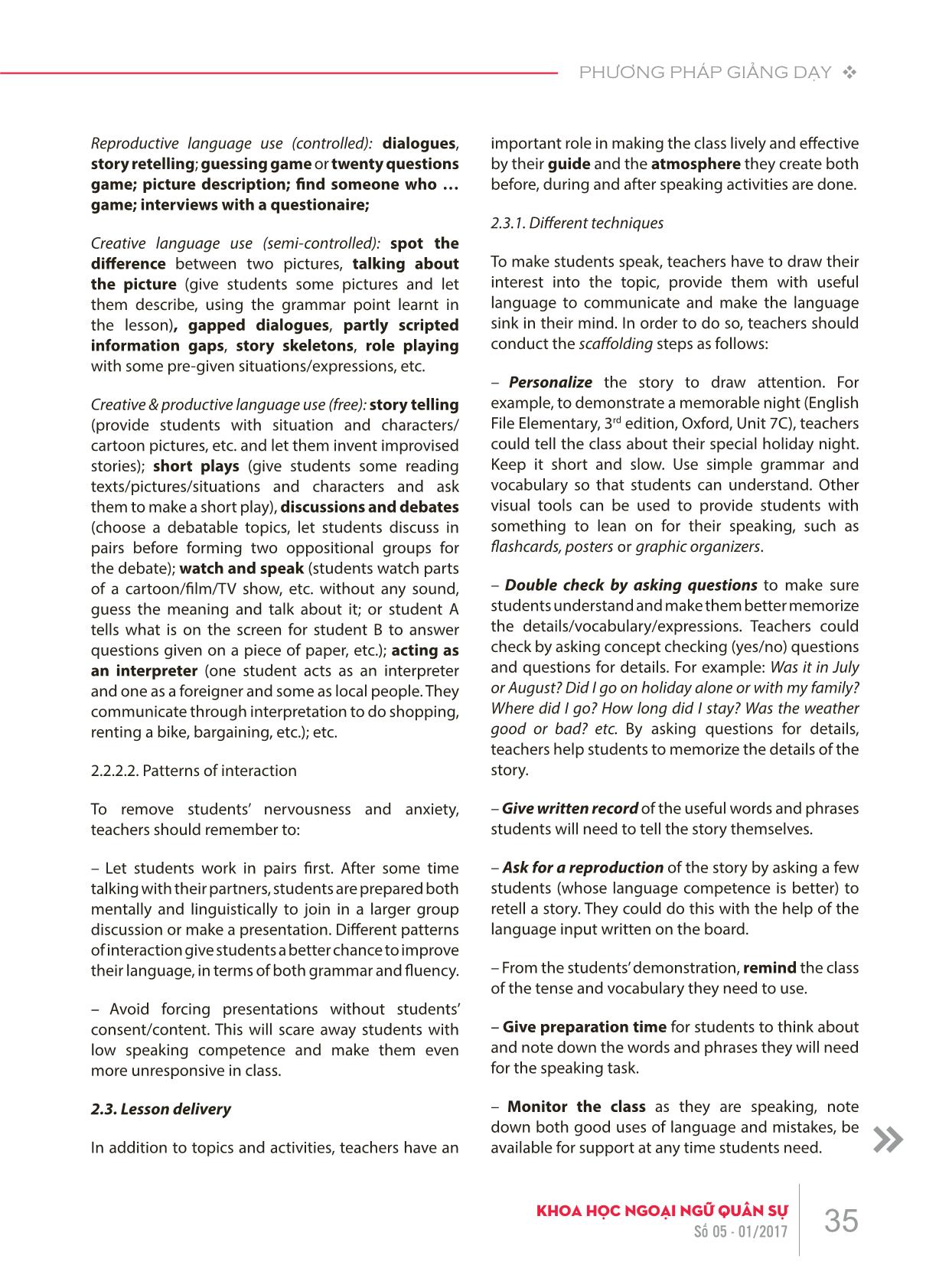
Trang 5
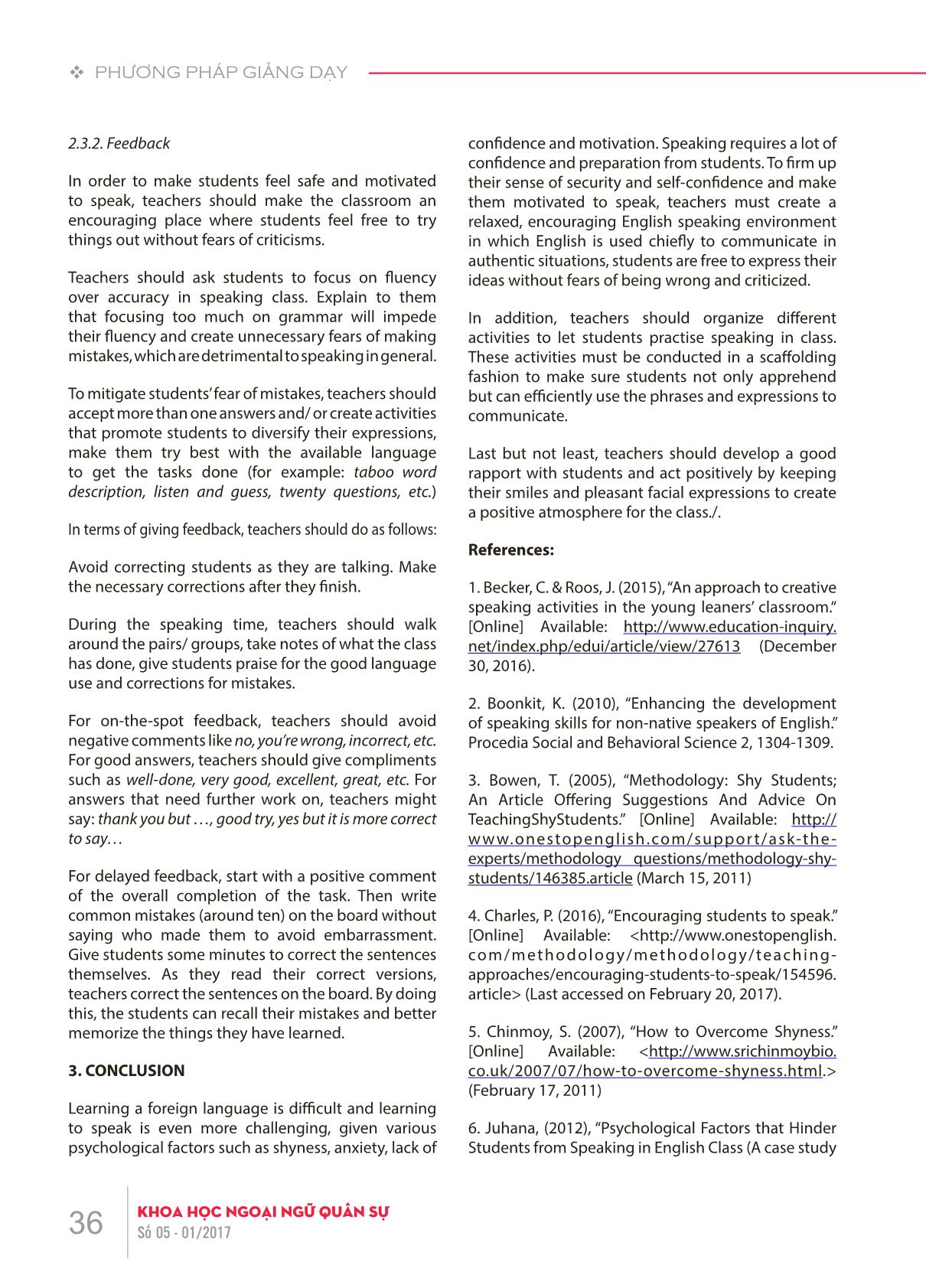
Trang 6
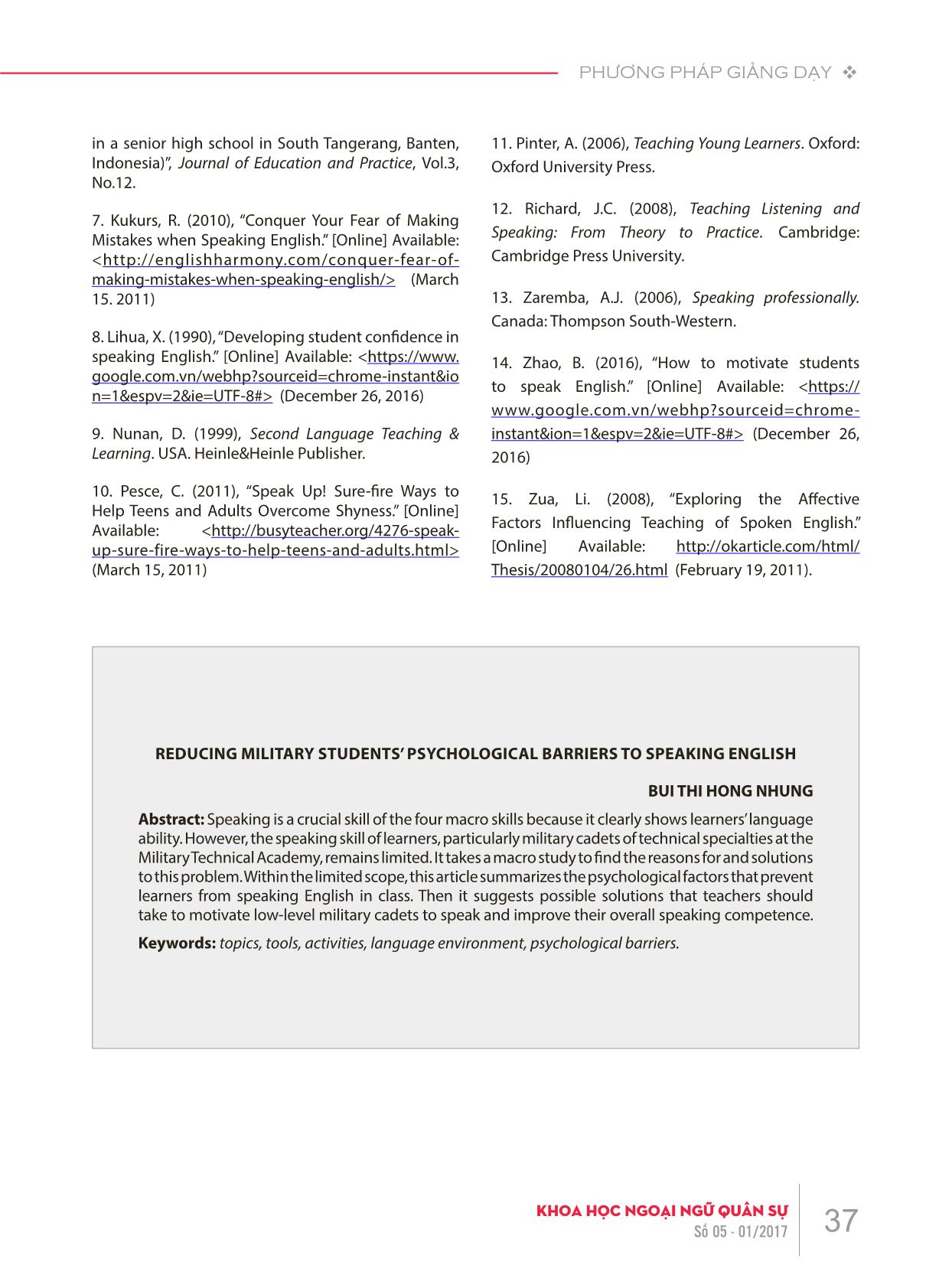
Trang 7
Tóm tắt nội dung tài liệu: Giảm thiểu yếu tố tâm lý cản trở học viên quân sự thực hành nói tiếng Anh
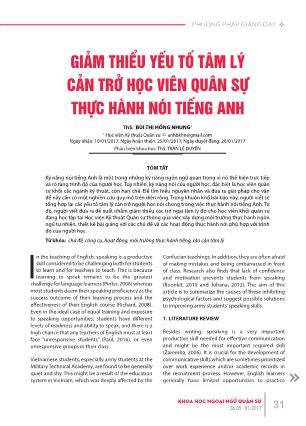
t music genres, to discuss anything or even do the quiz as they listen. Since the built-in speaking activity is also a music questionnaire, teachers should “work their way around” the topic. First, teachers should relate discussion topics to students’ lives and make them speak from their own experience. In this situation, a speaking activity around the music topic can help. Teachers should ask students to name their favourite singer, and then write some guiding questions on board: 34 KHOA HỌC NGOẠI NGỮ QUÂN SỰSố 05 - 01/2017 v PHƯƠNG PHÁP GIẢNG DẠY Who is your favourite singer? - My favourite singer is What is the person like? - He/she is very hand- some/beautiful/kind/cool, etc. Why do you like the person? - I like this person because After letting students ask and answer those questions in pairs for some minutes, teachers can screen pictures of some singers and ask questions, write students’ feedback on board and underline the verbs is and like. This can be a smooth way to introduce the grammar point (distinguishing between be and do) and finally a freer, less-controlled practice of speaking about the singers. Second, teachers should sometimes give students different topics and allow them to choose their favourite ones. After the allotted time for pair discussions, students will work in a bigger group, practicing ask and answer questions to and from other groups. Teachers can ask students to select some of the topics they like to talk about from the following list: Animals, Body and health, Classroom items and rules, Clothes, Colors, Daily activities, Dreams, Hobbies, Holidays, House and home, Family and relationship, Food, Transportation, Work and jobs, Pets, Sports, Travel, Festivals, etc. The tasks for students vary, from recovery dialogues, role plays to monologues or debates on a certain statement relating to the suggested topics. 2.2.2. Varied activities (tasks) Choosing a topic is important but another factor to stimulate students to speak is the desire to complete a task. Based on each class’s ability, teachers should try to modify a guided speaking activity and turn it into a communicative task. Here are a few things for setting up a speaking task: 2.2.2.1. Levels of controlledness Speaking tasks vary in forms but can be flexibly carried out through three phases, representing the controlledness of the task or the different levels of students’ independence in language use as follows (Becker and Roos, 2015, p.7): With beginning classes, teachers should start with a closely guided speaking task where fixed expressions are provided beforehand with thorough drilling. Such a guided task allows low-level students to speak imitatively and participate from their low levels. Guided, controlled activities help motivate students and strengthen their confidence. With higher level classes, teachers should ask students to perform more creatively with phrases/ expressions provided. Finally, at the top level, learners are free to use their individual linguistic repertoire in a meaningful context. In conclusion, a speaking task should move gradually towards providing opportunities for the negotiations of meaning. This is to stimulate learners to make the most of the language available to them to convey meanings. By doing this frequently, students develop creativity in finding alternative ways of expressing themselves, thereby extend their communicative competence. Based on the model of communicative speaking developed by Becker and Roos (2015), I would like to suggest a few speaking activities which I have applied in different classes as follows: Routine warm-up/wake-up speaking tasks: free talk (teachers ask a question and let students freely discuss with partners before the lesson); speaking and acting (teachers give orders and class act as soon as possible, i.e. shake your head, touch your ears, close your eyes, etc.); 35KHOA HỌC NGOẠI NGỮ QUÂN SỰSố 05 - 01/2017 PHƯƠNG PHÁP GIẢNG DẠY v Reproductive language use (controlled): dialogues, story retelling; guessing game or twenty questions game; picture description; find someone who game; interviews with a questionaire; Creative language use (semi-controlled): spot the difference between two pictures, talking about the picture (give students some pictures and let them describe, using the grammar point learnt in the lesson), gapped dialogues, partly scripted information gaps, story skeletons, role playing with some pre-given situations/expressions, etc. Creative & productive language use (free): story telling (provide students with situation and characters/ cartoon pictures, etc. and let them invent improvised stories); short plays (give students some reading texts/pictures/situations and characters and ask them to make a short play), discussions and debates (choose a debatable topics, let students discuss in pairs before forming two oppositional groups for the debate); watch and speak (students watch parts of a cartoon/film/TV show, etc. without any sound, guess the meaning and talk about it; or student A tells what is on the screen for student B to answer questions given on a piece of paper, etc.); acting as an interpreter (one student acts as an interpreter and one as a foreigner and some as local people. They communicate through interpretation to do shopping, renting a bike, bargaining, etc.); etc. 2.2.2.2. Patterns of interaction To remove students’ nervousness and anxiety, teachers should remember to: – Let students work in pairs first. After some time talking with their partners, students are prepared both mentally and linguistically to join in a larger group discussion or make a presentation. Different patterns of interaction give students a better chance to improve their language, in terms of both grammar and fluency. – Avoid forcing presentations without students’ consent/content. This will scare away students with low speaking competence and make them even more unresponsive in class. 2.3. Lesson delivery In addition to topics and activities, teachers have an important role in making the class lively and effective by their guide and the atmosphere they create both before, during and after speaking activities are done. 2.3.1. Different techniques To make students speak, teachers have to draw their interest into the topic, provide them with useful language to communicate and make the language sink in their mind. In order to do so, teachers should conduct the scaffolding steps as follows: – Personalize the story to draw attention. For example, to demonstrate a memorable night (English File Elementary, 3rd edition, Oxford, Unit 7C), teachers could tell the class about their special holiday night. Keep it short and slow. Use simple grammar and vocabulary so that students can understand. Other visual tools can be used to provide students with something to lean on for their speaking, such as flashcards, posters or graphic organizers. – Double check by asking questions to make sure students understand and make them better memorize the details/vocabulary/expressions. Teachers could check by asking concept checking (yes/no) questions and questions for details. For example: Was it in July or August? Did I go on holiday alone or with my family? Where did I go? How long did I stay? Was the weather good or bad? etc. By asking questions for details, teachers help students to memorize the details of the story. – Give written record of the useful words and phrases students will need to tell the story themselves. – Ask for a reproduction of the story by asking a few students (whose language competence is better) to retell a story. They could do this with the help of the language input written on the board. – From the students’ demonstration, remind the class of the tense and vocabulary they need to use. – Give preparation time for students to think about and note down the words and phrases they will need for the speaking task. – Monitor the class as they are speaking, note down both good uses of language and mistakes, be available for support at any time students need. 36 KHOA HỌC NGOẠI NGỮ QUÂN SỰSố 05 - 01/2017 v PHƯƠNG PHÁP GIẢNG DẠY 2.3.2. Feedback In order to make students feel safe and motivated to speak, teachers should make the classroom an encouraging place where students feel free to try things out without fears of criticisms. Teachers should ask students to focus on fluency over accuracy in speaking class. Explain to them that focusing too much on grammar will impede their fluency and create unnecessary fears of making mistakes, which are detrimental to speaking in general. To mitigate students’ fear of mistakes, teachers should accept more than one answers and/ or create activities that promote students to diversify their expressions, make them try best with the available language to get the tasks done (for example: taboo word description, listen and guess, twenty questions, etc.) In terms of giving feedback, teachers should do as follows: Avoid correcting students as they are talking. Make the necessary corrections after they finish. During the speaking time, teachers should walk around the pairs/ groups, take notes of what the class has done, give students praise for the good language use and corrections for mistakes. For on-the-spot feedback, teachers should avoid negative comments like no, you’re wrong, incorrect, etc. For good answers, teachers should give compliments such as well-done, very good, excellent, great, etc. For answers that need further work on, teachers might say: thank you but , good try, yes but it is more correct to say For delayed feedback, start with a positive comment of the overall completion of the task. Then write common mistakes (around ten) on the board without saying who made them to avoid embarrassment. Give students some minutes to correct the sentences themselves. As they read their correct versions, teachers correct the sentences on the board. By doing this, the students can recall their mistakes and better memorize the things they have learned. 3. CONCLUSION Learning a foreign language is difficult and learning to speak is even more challenging, given various psychological factors such as shyness, anxiety, lack of confidence and motivation. Speaking requires a lot of confidence and preparation from students. To firm up their sense of security and self-confidence and make them motivated to speak, teachers must create a relaxed, encouraging English speaking environment in which English is used chiefly to communicate in authentic situations, students are free to express their ideas without fears of being wrong and criticized. In addition, teachers should organize different activities to let students practise speaking in class. These activities must be conducted in a scaffolding fashion to make sure students not only apprehend but can efficiently use the phrases and expressions to communicate. Last but not least, teachers should develop a good rapport with students and act positively by keeping their smiles and pleasant facial expressions to create a positive atmosphere for the class./. References: 1. Becker, C. & Roos, J. (2015), “An approach to creative speaking activities in the young leaners’ classroom.“ [Online] Available: net/index.php/edui/article/view/27613 (December 30, 2016). 2. Boonkit, K. (2010), “Enhancing the development of speaking skills for non-native speakers of English.” Procedia Social and Behavioral Science 2, 1304-1309. 3. Bowen, T. (2005), “Methodology: Shy Students; An Article Offering Suggestions And Advice On TeachingShyStudents.” [Online] Available: http:// w w w.onestopengl ish.com/suppor t/ask-the - experts/methodology questions/methodology-shy- students/146385.article (March 15, 2011) 4. Charles, P. (2016), “Encouraging students to speak.” [Online] Available: < com/methodology/methodology/teaching- approaches/encouraging-students-to-speak/154596. article> (Last accessed on February 20, 2017). 5. Chinmoy, S. (2007), “How to Overcome Shyness.” [Online] Available: < co.uk/2007/07/how-to-overcome-shyness.html.> (February 17, 2011) 6. Juhana, (2012), “Psychological Factors that Hinder Students from Speaking in English Class (A case study 37KHOA HỌC NGOẠI NGỮ QUÂN SỰSố 05 - 01/2017 PHƯƠNG PHÁP GIẢNG DẠY v in a senior high school in South Tangerang, Banten, Indonesia)”, Journal of Education and Practice, Vol.3, No.12. 7. Kukurs, R. (2010), “Conquer Your Fear of Making Mistakes when Speaking English.” [Online] Available: < making-mistakes-when-speaking-english/> (March 15. 2011) 8. Lihua, X. (1990), “Developing student confidence in speaking English.” [Online] Available: <https://www. google.com.vn/webhp?sourceid=chrome-instant&io n=1&espv=2&ie=UTF-8#> (December 26, 2016) 9. Nunan, D. (1999), Second Language Teaching & Learning. USA. Heinle&Heinle Publisher. 10. Pesce, C. (2011), “Speak Up! Sure-fire Ways to Help Teens and Adults Overcome Shyness.” [Online] Available: < up-sure-fire-ways-to-help-teens-and-adults.html> (March 15, 2011) 11. Pinter, A. (2006), Teaching Young Learners. Oxford: Oxford University Press. 12. Richard, J.C. (2008), Teaching Listening and Speaking: From Theory to Practice. Cambridge: Cambridge Press University. 13. Zaremba, A.J. (2006), Speaking professionally. Canada: Thompson South-Western. 14. Zhao, B. (2016), “How to motivate students to speak English.” [Online] Available: <https:// www.google.com.vn/webhp?sourceid=chrome- instant&ion=1&espv=2&ie=UTF-8#> (December 26, 2016) 15. Zua, Li. (2008), “Exploring the Affective Factors Influencing Teaching of Spoken English.” [Online] Available: Thesis/20080104/26.html (February 19, 2011). REDUCING MILITARY STUDENTS’ PSYCHOLOGICAL BARRIERS TO SPEAKING ENGLISH BUI THI HONG NHUNG Abstract: Speaking is a crucial skill of the four macro skills because it clearly shows learners’ language ability. However, the speaking skill of learners, particularly military cadets of technical specialties at the Military Technical Academy, remains limited. It takes a macro study to find the reasons for and solutions to this problem. Within the limited scope, this article summarizes the psychological factors that prevent learners from speaking English in class. Then it suggests possible solutions that teachers should take to motivate low-level military cadets to speak and improve their overall speaking competence. Keywords: topics, tools, activities, language environment, psychological barriers.
File đính kèm:
 giam_thieu_yeu_to_tam_ly_can_tro_hoc_vien_quan_su_thuc_hanh.pdf
giam_thieu_yeu_to_tam_ly_can_tro_hoc_vien_quan_su_thuc_hanh.pdf

